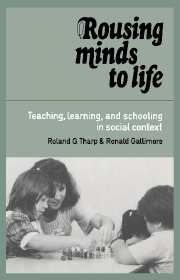Book contents
- Frontmatter
- Contents
- Acknowledgments
- Introduction
- Part I Teaching, schooling, and literacy: a unified theory of education
- Part II Practice
- 6 A school organized for teaching: the Kamehameha Elementary Education Program
- 7 The activity setting of the instructional conversation: developing word and discourse meaning
- 8 The orchestration of activity settings: learning and social interaction in the whole group and independent centers
- 9 The interpsychological plane of teacher training
- 10 Assisting teacher performance through the ZPD: a case study
- 11 The intrapsychological plane of teacher training: the internalization of higher-order teaching skills
- 12 The schools in mind and society
- References
- Author index
- Subject index
8 - The orchestration of activity settings: learning and social interaction in the whole group and independent centers
Published online by Cambridge University Press: 05 June 2012
- Frontmatter
- Contents
- Acknowledgments
- Introduction
- Part I Teaching, schooling, and literacy: a unified theory of education
- Part II Practice
- 6 A school organized for teaching: the Kamehameha Elementary Education Program
- 7 The activity setting of the instructional conversation: developing word and discourse meaning
- 8 The orchestration of activity settings: learning and social interaction in the whole group and independent centers
- 9 The interpsychological plane of teacher training
- 10 Assisting teacher performance through the ZPD: a case study
- 11 The intrapsychological plane of teacher training: the internalization of higher-order teaching skills
- 12 The schools in mind and society
- References
- Author index
- Subject index
Summary
If the instructional conversation is so essential for cognitive growth during schooling, why is it so seldom implemented? Why does the ubiquitous recitation script continue?
Shuy goes to the root of the matter by suggesting that these matters have “little to do with learning and or teaching as such, but instead grow out of economic interests. Teachers faced with thirty or more students in one classroom find it difficult to dialogue in an effective way with one student in any developmentally productive way” (Shuy, 1986, P. 3).
Again we see that effective teaching can occur only in a context of effective schooling. Effective schooling means the design of productive activity settings, and that requires major additions of resources, or major changes in their deployment. Although we all know that more teaching personnel are needed by schools, there are also improvements available if better priorities are adopted and better design of classrooms is achieved. For example, even with typical resources, if the teacher dialogues with a small group of students, many of the benefits of the instructional conversation will accrue. The teacher can be freed to engage in small-group discussions only if the other students are meanwhile engaged in productive activity settings.
Activity settings of the classroom must be orchestrated to allow instructional conversations, joint productive activity, and assistance to performance in the ZPD. In this chapter we discuss the other two activity-setting types that are necessary in the conduct of effective schooling: whole-group settings and independent-group settings.
- Type
- Chapter
- Information
- Rousing Minds to LifeTeaching, Learning, and Schooling in Social Context, pp. 161 - 187Publisher: Cambridge University PressPrint publication year: 1989



